Animation &Disney &Frame Grabs &Layout & Design 20 Jun 2011 06:56 am
Pinocchio – Multiplane
- In highlighting the use of the multiplane camera in Disney’s animated films, the pinnacle has to be Pinocchio. Two specific scenes jump out in any mention of the multiplane camera: the move in to Gepetto’s workshop and the awakening of the village.
So let’s get right into it:
Sequence director: Ham Luske
Layout by Hugh Hennesy
Animated by “Music Room 2″
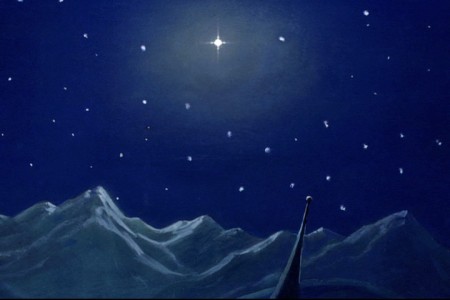 1
1Start in the sky with the wishing star that will play
a large part in the film in a couple of moments.
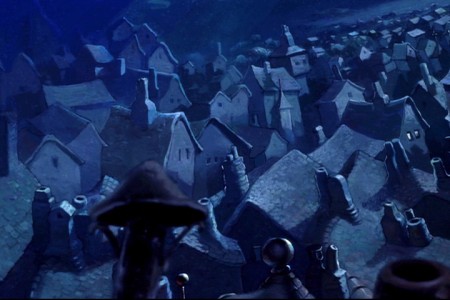 2
2
Circle down from the sky field to an overhead of the village.
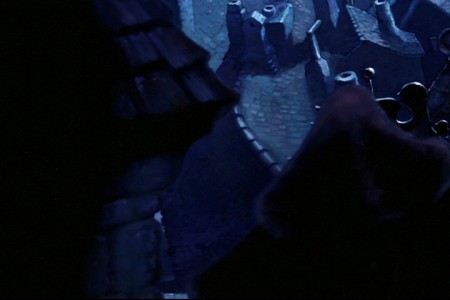 3
3
Continue moving down over the rooftops.
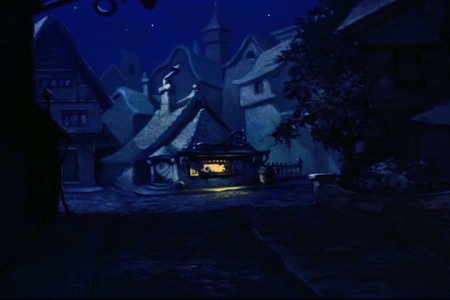 5
5
We first see Gepetto’s workshop from a distance.
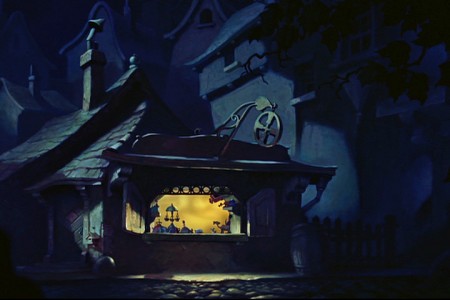 6
6
There’s a matching cut and we continue to move in.
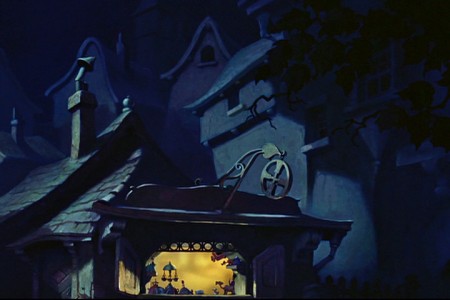 7
7
The POV of the camera is through Jiminy’s eyes.
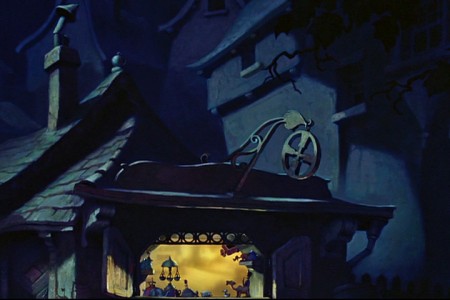 8
8
When he moves in, it’s in hops.
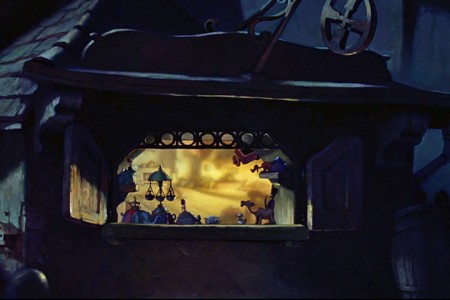 10
10
Leaps and bounds as he (through our camera’s eye) gets closer.
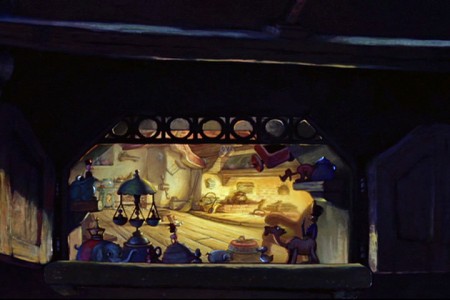 12
12
The warm window into the workshop begins to fill the screen.
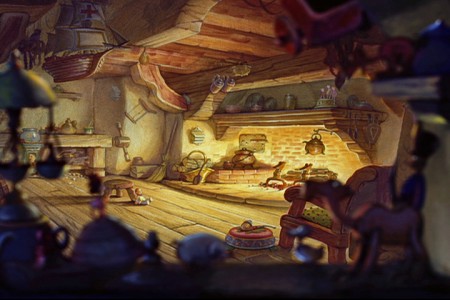 15
15
. . . looking into the workshop through the window.
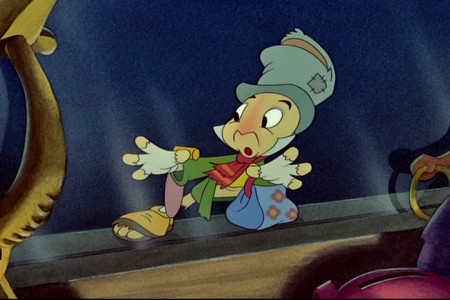 16
16
Cut to an interior shot – the interior side of the window.
Jiminy Crickey, with hands and face up to the glass.
Then we move onto a miracle of a shot that would be hard even for computer users. Today, we wouldn’t anchor the feet properly on all those kids walking and running about. It’s an amazing piece of animation history.
The sequence director was Wilfred (“Jaxon”) Jackson.
Layout by Thorington C. “Thor” Putnam.
The animators involved in this scene include: John McManus, Jack Campbell, Cornett Wood, John Reed, Art Babbitt, Milt Kahl, Don Lusk, and Sandy Strother.
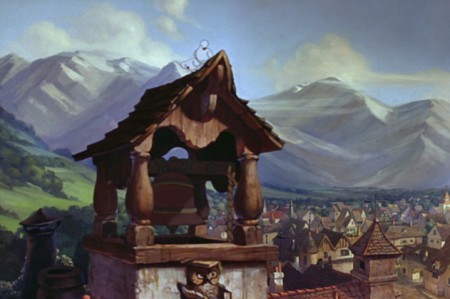 1
1The camera starts at the bell tower over the sleeping village.
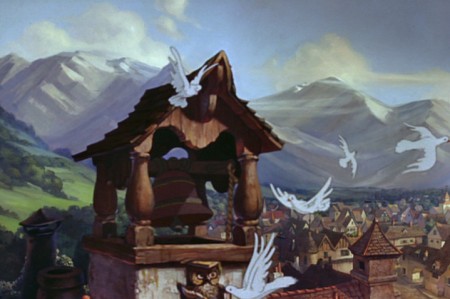 2
2
Doves fly out as the bell starts to chime.
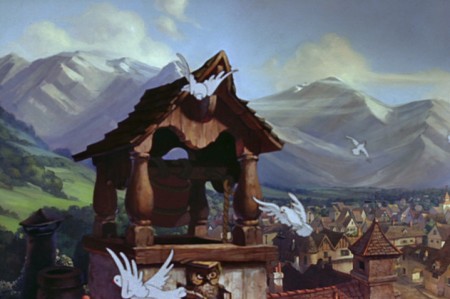 3
3
The birds fly out of focus as they move forward.
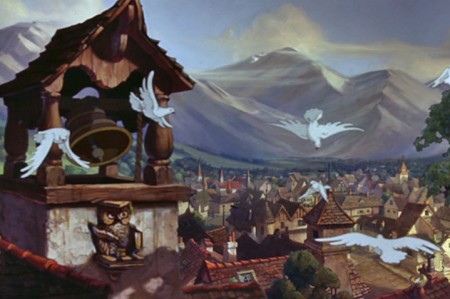 4
4
This allows the camera to start the big move
with the birds covering the tower.
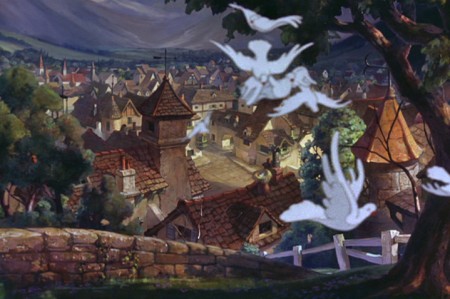 6
6
The camera pushes in to cross the
little footbridge to enter the town.
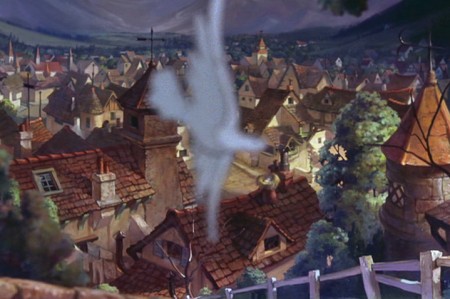 7
7
The last bird leaves us, and . . .
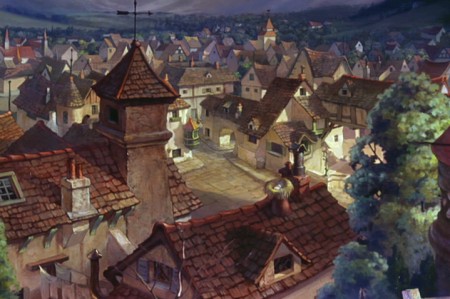 8
8
. . . we’re into the village.
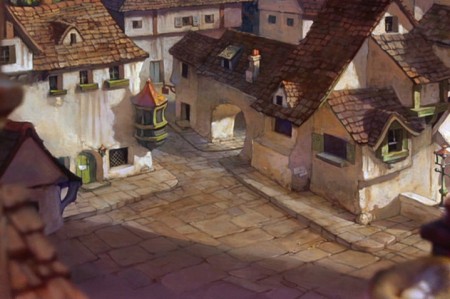 10
10
We move in toward the cross section of the town . . .
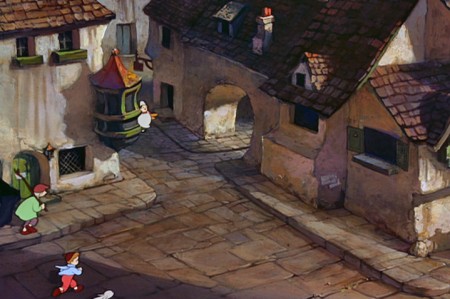 11
11
. . . as people start to come out of their houses.
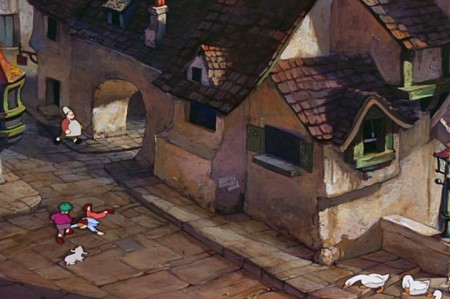 12
12
The camera moves to the right.
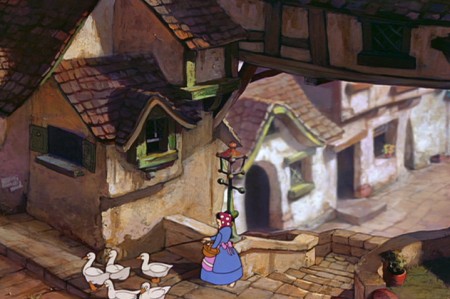 13
13
We move toward a woman with geese as the
camera goes under an overpass.
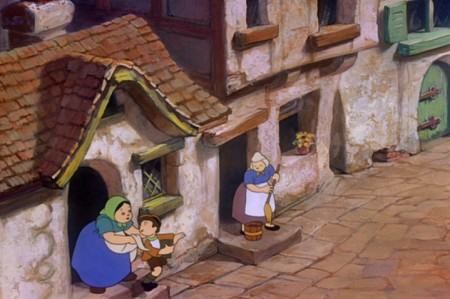 15
15
We head a few steps down as more
chldren come out running to school.
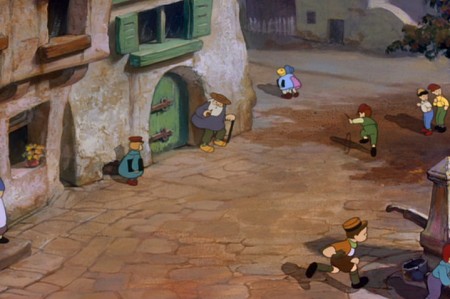 17
17
The camera continues to the right
seemingly led there by one running boy.
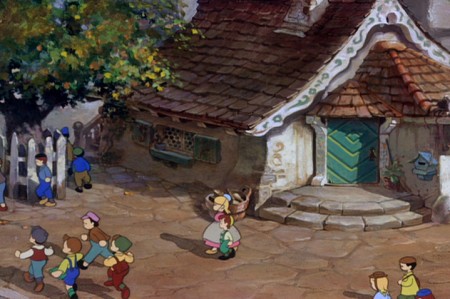 19
19
. . . reaching Gepetto’s house.
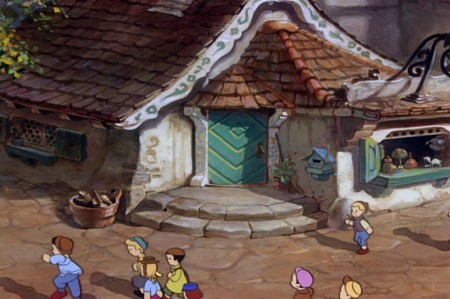 20
20
The camera moves in on the house.
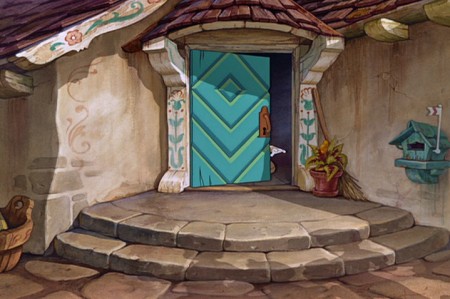 21
21
At this time we cut in and the big-time animators take over.
Milt Kahl handles Pinocchio, Art Babbitt does Gepetto, Don Lusk animates Figaro.
Although there are numerous beautiful scenes from Pinocchio that employ the multiplane camera, there’s one last sequence I’d like to concentrate on. This is where J. Worthington Foulfellow (“Fox”) and Gideon the cat cajole Pinocchio into following them so that they can sell him to the puppetmaster, Stromboli. This is a particularly interesting scene for the multiplane camera.
The sequence director was T. Hee.
Layout by Ken O’Connor.
The animators involved in this scene include: Ugo D’Orsi, Jack Campbell, Hugh Fraser, Charles Nichols, Marvin Woodward, Preston Blair, Milt Kahl and Charles Otterstrom and
Phil Duncan.
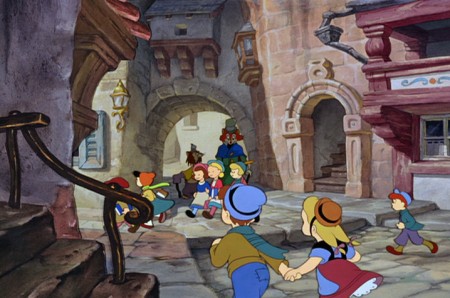 1
1The multiplane camera scene is several away from this,
but I feel as though this scene really sets up the big one.
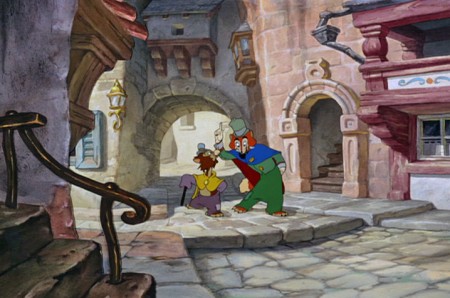 2
2
We properly meet the fox and cat as they walk through the town.
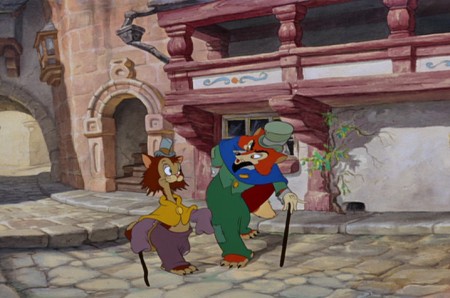 3
3
They are well into conversation.
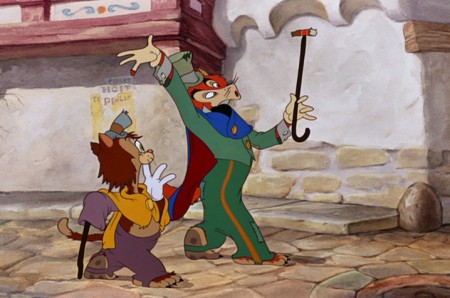 5
5
The fox picks up a cigar stub, telling us about their financial state.
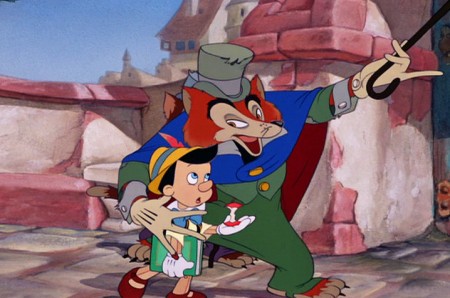 7
7
Several short scenes later, they run into Pinocchio and
coax him away from school to follow them to the theater.
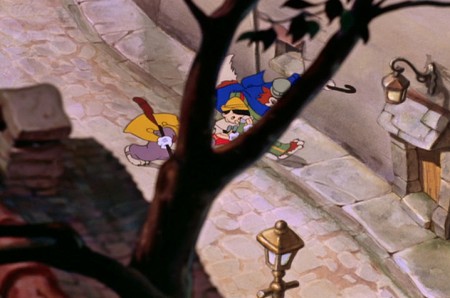 9
9
This cuts into the overhead multiplane shot.
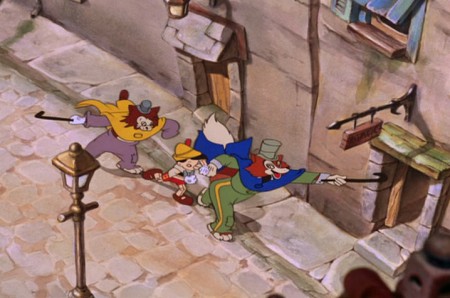 11
11
We watch from overhead with trees and ornaments
marginally blocking our vision of the characters.
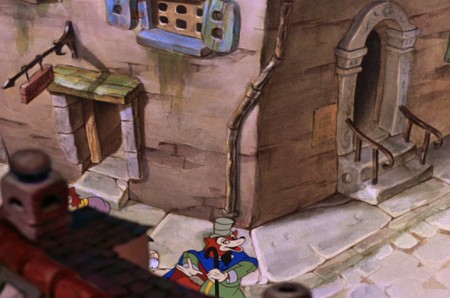 13
13
They turn a corner and the camera follows them.
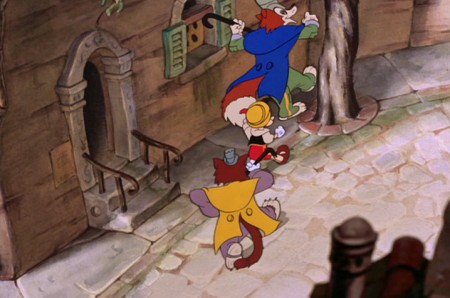 17
17
A quick circling of the tree.
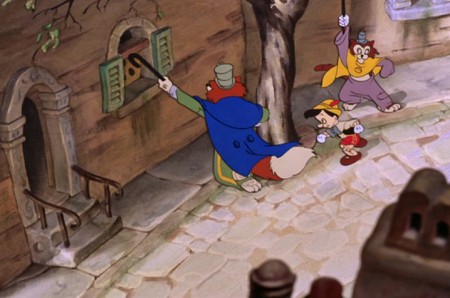 19
19
They do it again, but . . .
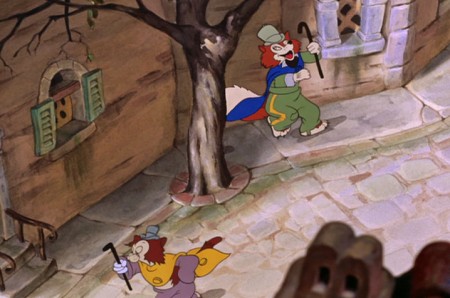 20
20
. . . Gideon the cat continues forward moving off screen.
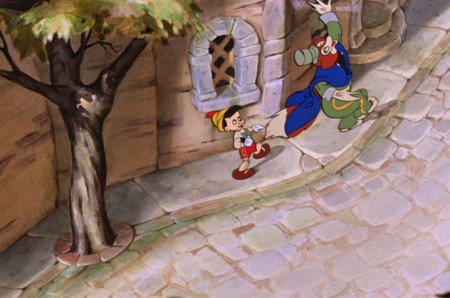 21
21
The fox and Pinocchio continue on the path.
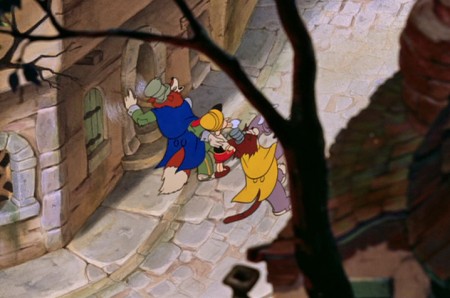 23
23
. . . catching up with them.
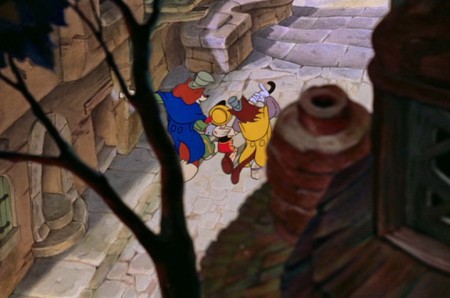 24
24
We view them through a tree and the side of a building.
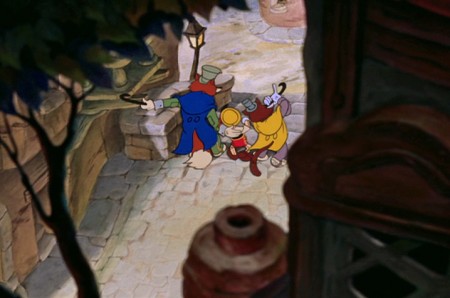 25
25
They go up several steps, but the camera stops.
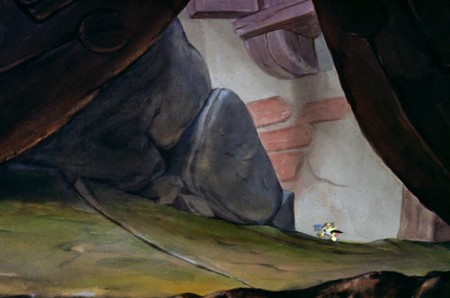 28
28
. . . the next scene, Jiminy Cricket is running. He’s late trying
to catch up to Pinocchio, thinking he’s on the way to school.
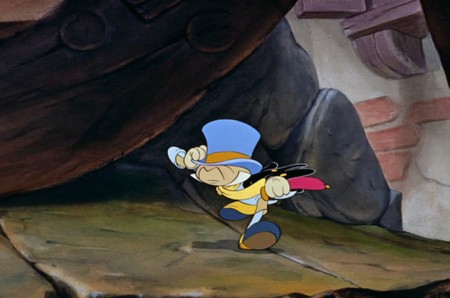 29
29
Jiminy is animated here by Phil Duncan.
David Nethery correctly points out in the comment section,
that Milt Kahl animated this scene.
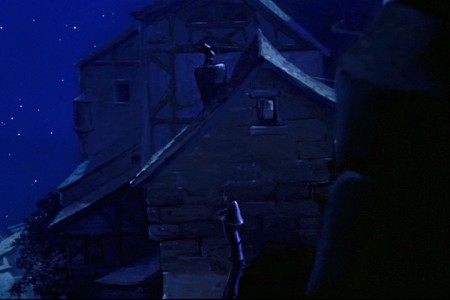
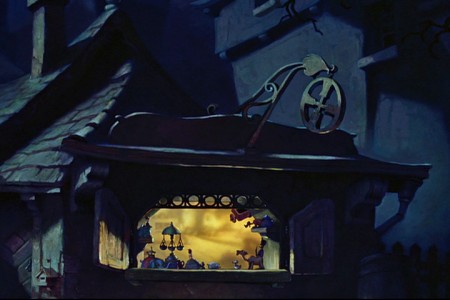
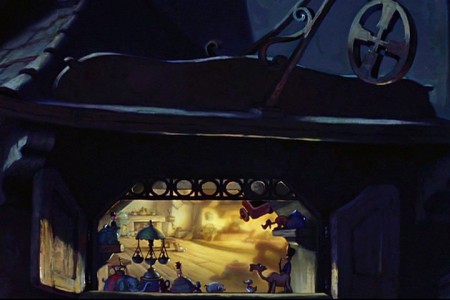
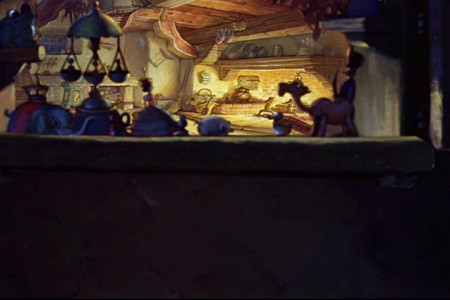
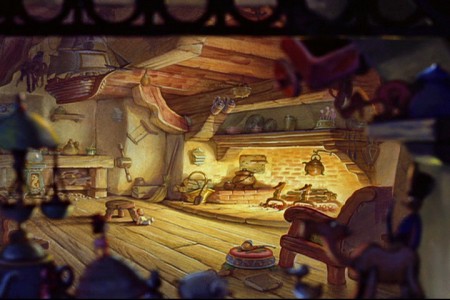
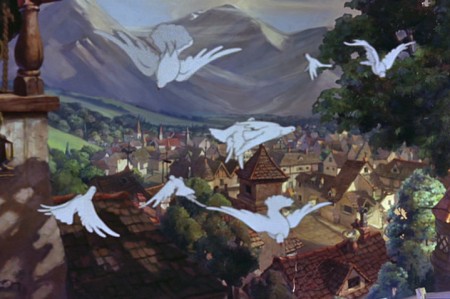
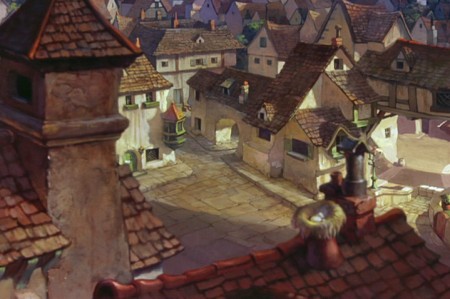
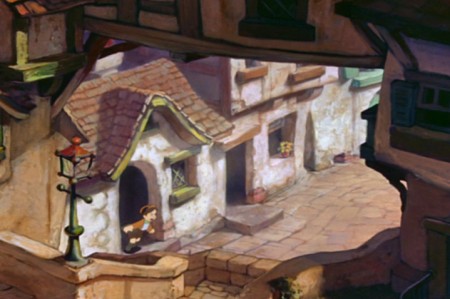
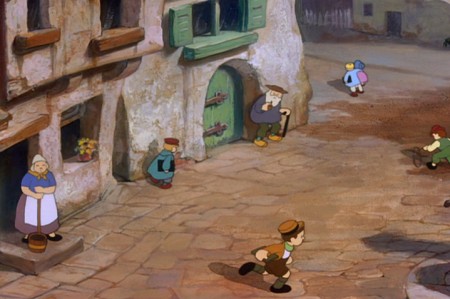
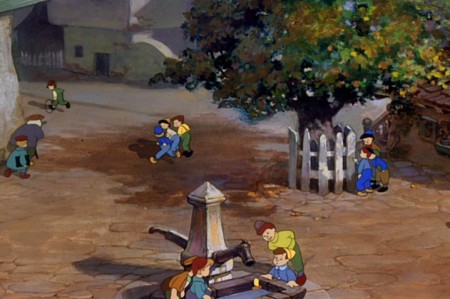
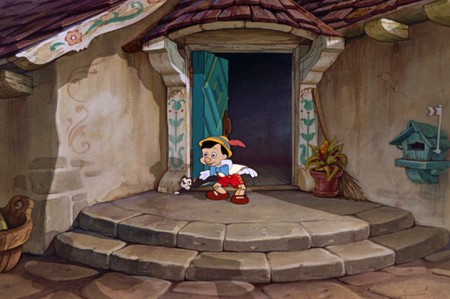
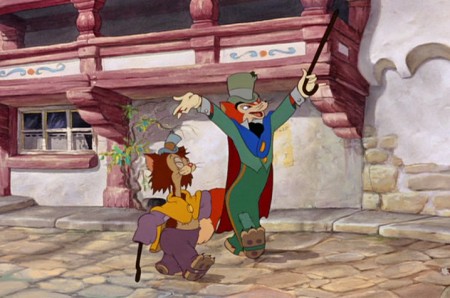
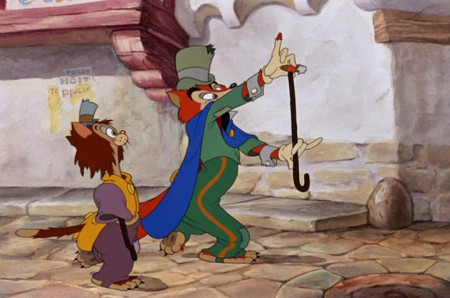
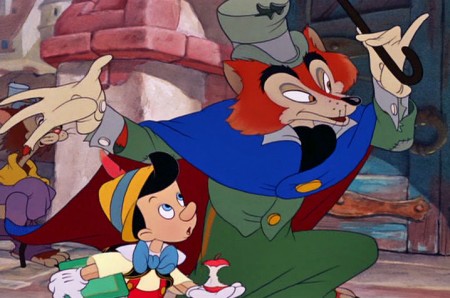
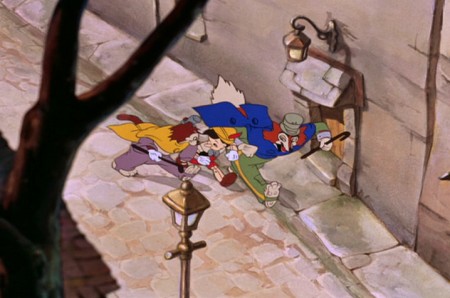
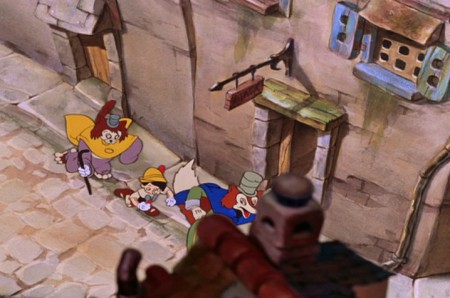
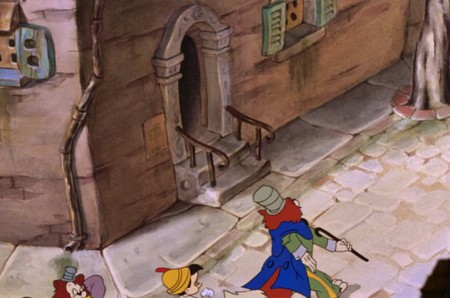
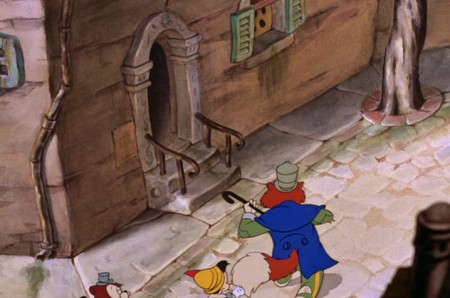
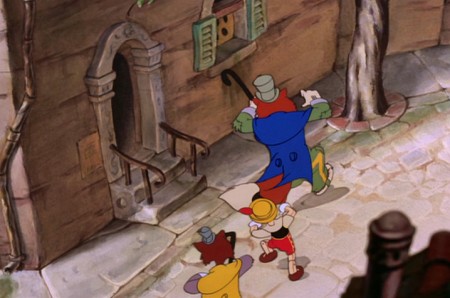
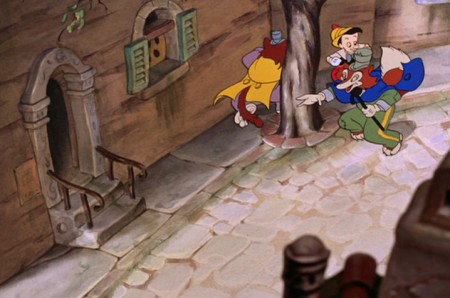
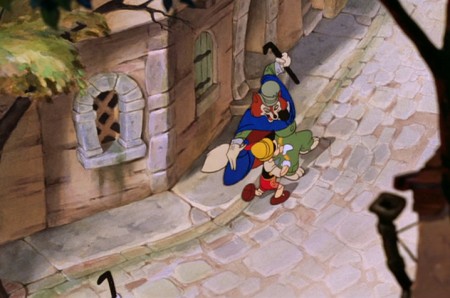
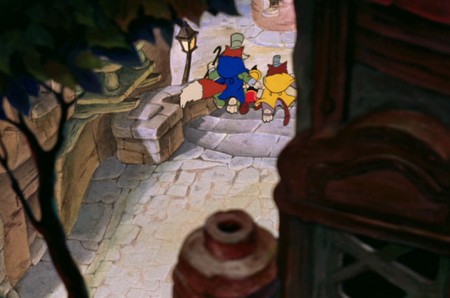
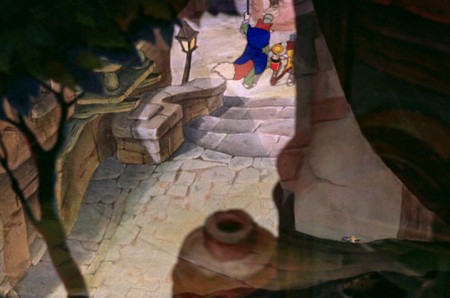

on 20 Jun 2011 at 9:28 am 1.Pierre said …
Does anyone know if the folks at Disney created the shadows under the character’s feet on a separate pass or if they were using some kind of transparent paint?
It’s a detail like transparent shadows that makes these sequences all the more remarkable. It’s also the reason why I can’t imagine they would have done the shadows on a separate pass but I wouldn’t have put it past them!
on 20 Jun 2011 at 9:47 am 2.Michael said …
I believe they varied the technique. I doubt they’d use a separate pass with the multiplane camera (and if you look closely you can see an outline to the shadow meaning they used transparent paint). But in the last scene with Jiminy running it’s a separate pass.
on 20 Jun 2011 at 10:30 am 3.Grant said …
The backgrounds of Gepetto’s house where Jiminy leaps forward are very large–6 ft. across. The background painters used larger brushes to match the scale of the normal/smaller backgrounds.
The massive-classice (the only shot coming close is the opening of Bambi)) multiplane shot of Pinocchio’s first day of school skirted jittering and saved some work by animating some of the work on every other level on 2′s, but replacing every other level on 1′s. Amazing trick to maintain weight to the scene without getting all weird on 1′s.
on 20 Jun 2011 at 11:18 am 4.Stephen Perry said …
The going to school multiplane is probably the only one that you do notice the changes in exposure as they mix off each level above the ones below, as you pass through a clear area in the glass painting. Maybe why they tended to stick with darker multiplane scenes in the rest of Pinocchio and other films. This is the brightest multiplane shot I think they ever did? They must have painted each level brighter than the one above and altered the exposure in the mix to the next top level? easier to control in darker shots.
on 20 Jun 2011 at 2:52 pm 5.Grant said …
That most of Pinocchio’s multiplane shots were made with the horizontal multiplane vs. the vertical multiplane is less well known.
on 20 Jun 2011 at 11:26 pm 6.Ray Kosarin said …
Breathtaking work. Complicated mechanics done so well as (for most viewers) to be invisible — as it should be.
on 21 Jun 2011 at 5:41 am 7.Stephen Perry said …
They couldn’t use the horizontal multiplane with animation levels, otherwise they’d be limited to pan shots like the Fleischer’s with their use of models on a large frame by frame rotating disk and the character cels sandwiched between two sheets of verticle glass infront of the horizontal disk.
Disney’s were able to shoot each level on it’s own with the other levels blacked out, then rewind the film and shoot the next level, with the level above having the lights turned off creating its own matte.
So it would’ve made DX’ing the shadows much easier for that or any other level.
on 21 Jun 2011 at 7:04 am 8.Michael said …
Shooting each level on its own then going back and reshooting for the next level would have voided any reason for using the multiplane camera. The levels grow gradually out of focus and you can’t matte in an out of focus level. You’d have to have a hard line to make it work. They could have done shadows on their own run or burned in a lighter color, but that’s about it.
on 21 Jun 2011 at 11:15 am 9.David Nethery said …
As usual you treat us to great screen captures and intelligent analysis of these amazing shots.
I don’t have much to add except to note the last screen capture (#29) is labeled “Jiminy is animated here by Phil Duncan.” but I believe that is a Milt Kahl scene where Jiminy is running along late for work , still getting dressed as he runs. However, I checked the Draft and it does credit the scene to “Kahl/Duncan” (and also to “Otterstrom/Meador” for effects animation). I believe Kahl animated Jiminy in this scene , then at the end of the scene we see the legs (animated by Phil Duncan) of the Fox, Pinocchio, and the Cat march past as Jiminy (by Kahl) says “Oh boy, a parade!” before he recognizes Pinocchio and goes into a take: “HUH!?”
on 21 Jun 2011 at 2:38 pm 10.Michael said …
I’m sure you’re right, David. I actually wrote that when I posted drawings from the Jiminy scene a couple of years ago.
Go here to see that post.
Dumb me.
on 21 Jun 2011 at 6:05 pm 11.Grant said …
They did indeed use the horizontal multiplane with animation levels. A lot. In fact, MOSTLY for the early features. They were not “bi-packing” nor were they using double exposure on these particular shots. The shadows for most of these shots were a semi-transparent paint that consisted of ink and (no joke) horse piss. It takes a long time to dry, and it STINKS!
on 21 Jun 2011 at 6:10 pm 12.Grant said …
And the “faux” multiplane revealing Briar Rose’s forest home in Sleeping Beauty doesn’t cut it. They should have either made it multiplane (and it’s not) or kept it 100% flat. Instead, they pull overlays apart…and it’s just not the same.
Check out the Herman Schultheis documentary on the recent Fantasia blu-ray, or better yet, check out his notebook at the Walt Disney Family Museum if you want to see how these worked. Disney didn’t really do bi-packing until the ’70′s when don bluth did it to cut costs. It always looks cheap.
on 22 Jun 2011 at 6:46 am 13.John V. said …
David: Actually, Phil Duncan just animates Pinocchio, Charles Otterstrom animates the Fox and the Cat.
This is the only sequence where Kahl animates Jiminy (he animates both characters when Jiminy is standing in the flower trying to convince Pinocchio not to go with “Honest John”). I don’t know why this is, but T.Hee’s sequences to cast Jiminy’s animators quite strangely: the other sequence where Pinoc meets Honest John and Gideon has Jiminy animated by Harvey Toombs, who also mainly animated the title character.
on 22 Jun 2011 at 10:16 am 14.Stephen Perry said …
Not true, any matte box on a camera whereby you slide in mattes to black-out one side and then rewind the film and cover the side just shot to expose the other side, the matte is out of focus…
The focus on the multiplane wouldn’t change by having one level blacked out as the camera tracks in through the lit level and you don’t need to have mattes hard edged, hard edged mattes are harder to control than soft edge mattes.
on 22 Jun 2011 at 10:23 am 15.Grant said …
That doesn’t change the fact that Disney did not do it that way. They didn’t. Disney multiplane was always “in camera.”
on 23 Jun 2011 at 5:38 am 16.Stephen Perry said …
Well if you read the section on the multiplane camera in The Illusion of Life, they mention turning the lights out on levels rewinding the film and shooting them as a second run with the lights just on that level, all on the multiplane, not on another camera, which you seem to think I’m talking about..
on 24 Jun 2011 at 10:27 am 17.Grant said …
The Illusion of Life is very misleading…and that information is incorrect. That is, until the 1970′s.
on 27 Jun 2011 at 10:03 am 18.Stephen Perry said …
I think if they had the ability to put a mirror at a 45 degree angle on a lower plane and reflect flat artwork into the field of view, plus use rear projection on the Multiplane then anything was possible.
on 07 Nov 2024 at 3:46 am 19.???????? ???????? ????????? ?? ????? ?????? said …
I’ll immediately take hold of your rss as I can’t find
your email subscription hyperlink or e-newsletter service.
Do you’ve any? Please allow me realize so that I may subscribe.
Thanks.